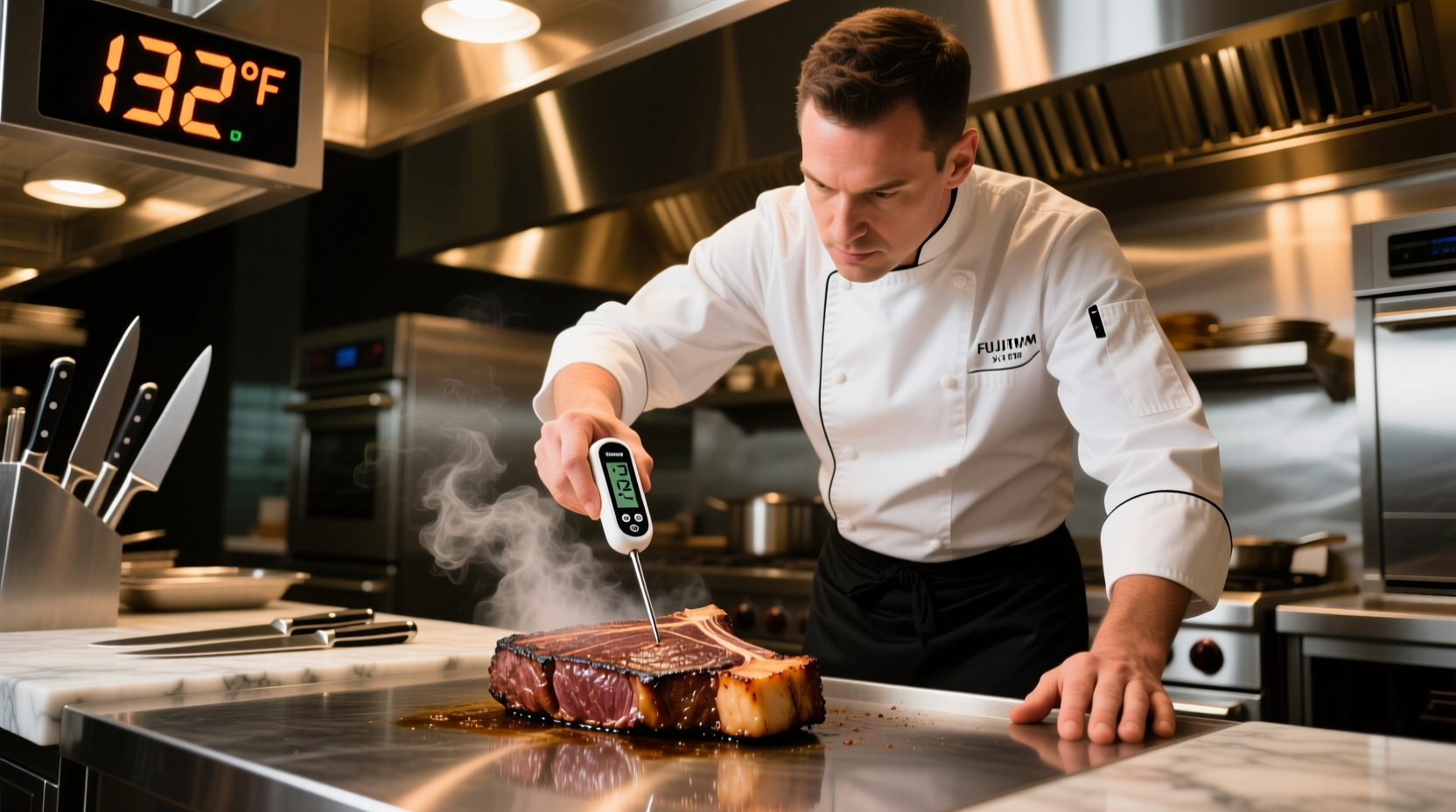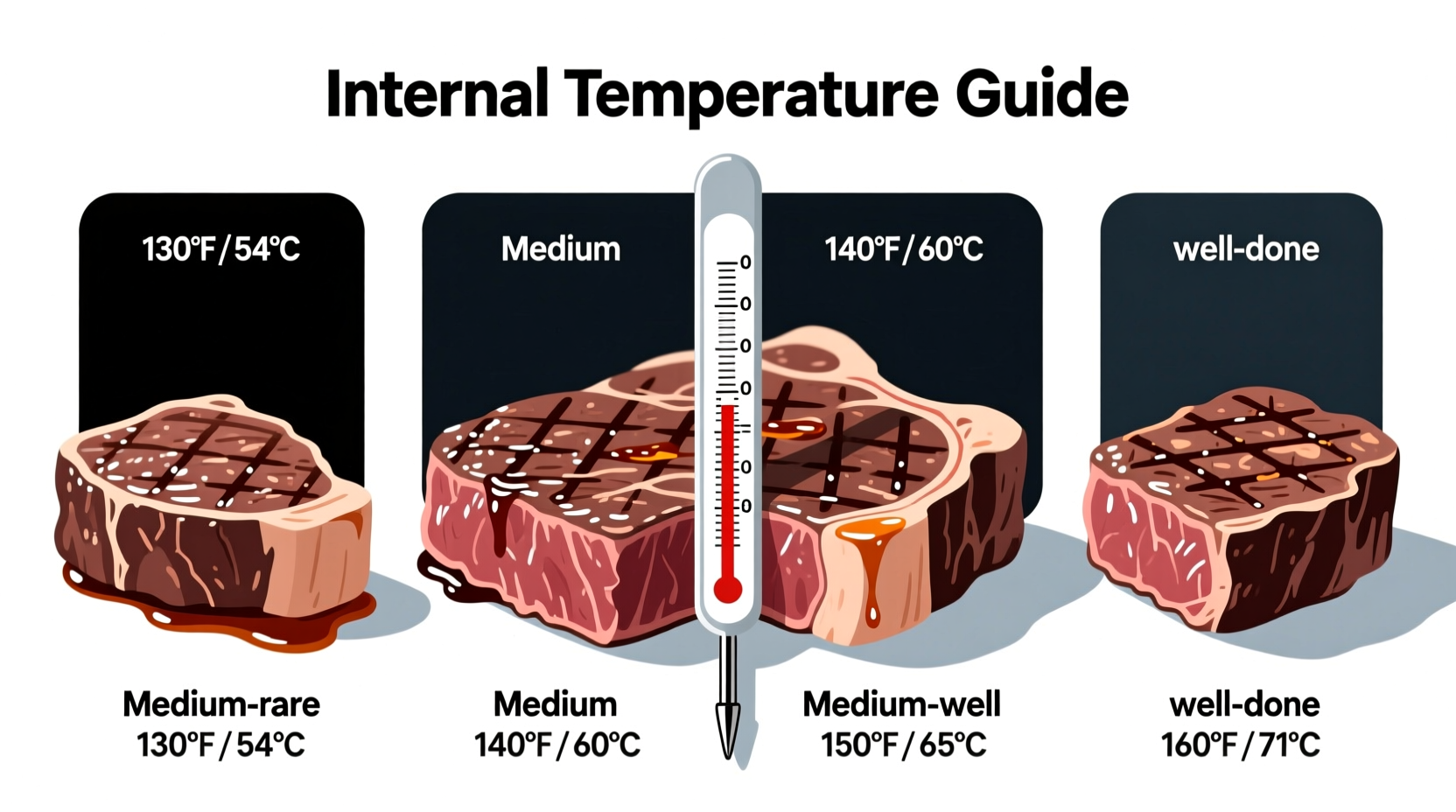The ideal internal temperature for steak depends on your preferred doneness level, but the USDA recommends a minimum safe temperature of 145°F (63°C) with a 3-minute rest time for beef steaks. For precise results: rare steak reaches 120-125°F, medium-rare 130-135°F, medium 140-145°F, medium-well 145-155°F, and well-done 155°F+. Always use a calibrated meat thermometer for accuracy—never rely solely on cooking time or appearance.
Getting steak temperature right transforms your cooking from guesswork to precision. Whether you're grilling outdoors or searing indoors, understanding exact temperature targets ensures perfect results every time while keeping your meal safe to eat. This guide delivers scientifically-backed temperature guidelines used by professional chefs, complete with practical measurement techniques and common pitfalls to avoid.
Why Steak Temperature Matters More Than You Think
Temperature isn't just about doneness—it's critical for both food safety and texture. Undercooked steak risks E. coli and other pathogens, while overcooked steak becomes tough and dry. The USDA's Food Safety and Inspection Service established minimum internal temperatures to eliminate harmful bacteria. For beef steaks, the official guideline specifies 145°F (63°C) with a 3-minute rest period. However, many culinary professionals safely prepare medium-rare steak at 130-135°F because whole-muscle cuts like steaks have surface bacteria that proper searing destroys.
| Doneness Level | Internal Temperature | Visual & Texture Indicators |
|---|---|---|
| Rare | 120-125°F (49-52°C) | Cool red center, very soft texture |
| Medium-Rare (Recommended) | 130-135°F (54-57°C) | Warm red center, tender with slight resistance |
| Medium | 140-145°F (60-63°C) | Warm pink center, firmer texture |
| Medium-Well | 145-155°F (63-68°C) | Small amount of pink, slightly dry |
| Well-Done | 155°F+ (68°C+) | Little or no pink, dry and firm |
How Temperature Recommendations Have Evolved
Steak temperature guidelines have shifted significantly over time as food safety research advanced. In the 1990s, many chefs cooked steaks to lower temperatures without widespread safety concerns. However, after E. coli outbreaks linked to undercooked ground beef in the mid-1990s, the USDA revised its recommendations. The current 145°F standard for whole-muscle cuts was established in 2011 based on research showing this temperature effectively kills pathogens while preserving quality. Interestingly, the FDA Food Code still permits restaurants to serve steak at 130°F for 112 minutes when properly disclosed to customers—a technique called combinatorial cooking that uses time and temperature together for safety.
Measuring Temperature Like a Professional Chef
Accurate temperature measurement requires proper technique:
- Use an instant-read thermometer - Digital thermometers provide readings in 2-5 seconds
- Insert correctly - Place probe into the thickest part, avoiding bone or fat
- Check multiple spots - Especially on irregular cuts like ribeye
- Calibrate regularly - Test in ice water (32°F/0°C) or boiling water (212°F/100°C)
Many home cooks make the critical mistake of checking temperature too early or too frequently, which releases juices. For best results, check only during the final 2-3 minutes of cooking. Remember that temperature continues rising 5-10°F during resting—this carryover cooking means you should remove steak from heat 5°F below your target temperature.

Special Considerations for Different Steak Types
Not all steaks follow the same temperature rules. Thicker cuts like tomahawk or cowboy steaks require different approaches than thinner cuts:
- Thick-cut steaks (1.5+ inches) - Use reverse sear method: cook low and slow to target temperature, then sear
- Thin steaks (under 1 inch) - Cook quickly over high heat; harder to achieve medium-rare without overcooking
- Marbled cuts (ribeye, Wagyu) - Fat renders at lower temperatures; may appear more done than thermometer indicates
- Lean cuts (filet mignon) - More prone to drying out; best served medium-rare or rarer
When cooking thicker steaks, the temperature gradient becomes crucial. A 2-inch thick steak might have a 30°F difference between the edge and center when seared traditionally. This is why the reverse sear method has gained popularity among professionals—it creates more even cooking from edge to center.
Avoiding Common Steak Temperature Mistakes
Even experienced cooks make these temperature-related errors:
- Relying on cooking time alone - Variables like grill temperature and steak thickness make time unreliable
- Not accounting for carryover cooking - Removing steak at exact target temperature results in overcooking
- Using the wrong thermometer type - Oven-safe thermometers aren't precise enough for steak
- Checking temperature too early - Opening the grill or oven too often slows cooking and dries meat
One often-overlooked factor is the steak's starting temperature. Taking steak directly from the refrigerator to the grill creates a larger temperature gradient. For more even cooking, let steak sit at room temperature for 30-60 minutes before cooking—but never leave it out longer than 2 hours for food safety.
When Visual Cues Complement Temperature Readings
While thermometers provide objective data, understanding visual indicators creates a more complete picture:
- Rare - Deep red center, very soft when pressed
- Medium-rare - Warm red center, yields slightly to pressure
- Medium - Pink center, firm but yielding texture
- Well-done - Little to no pink, very firm with springy resistance
Professional chefs often use the hand test as a secondary check: compare the firmness of your steak to the fleshy part of your palm below the thumb. Rare feels like when thumb touches index finger, medium-rare like thumb touching middle finger, and so on. However, this method requires practice and should never replace thermometer use for food safety.
Frequently Asked Questions
These common questions address key concerns about steak temperature guidelines:











 浙公网安备
33010002000092号
浙公网安备
33010002000092号 浙B2-20120091-4
浙B2-20120091-4